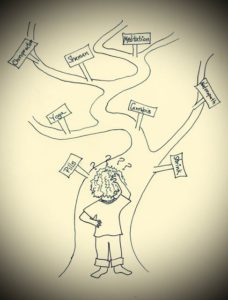Have you tried………?
Somewhere on the long, winding road we travel seeking a remedy for our migraine pain, most of us resort to so-called alternative treatments. We tend to pigeonhole curatives such as acupuncture, rolfing, homeopathy and cannabis as “out there,” unproven, therefore worth less than the pills and surgeries prescribed by our doctors. Yet we all have much to learn from the health and spiritual practices that come to us from the East and elsewhere around the globe: acupuncture, Tai chi and Qigong from China, Buddhist spiritual practices from Japan and Tibet, ayurveda and yoga from India, Native American healing from throughout the Americas, and more.
Every individual’s migraines are different, and the cause of migraine continues to be poorly understood. I believe it is not only sensible to explore all avenues to improve your health but imperative to stay open to trying new treatments, new doctors, spiritual practices and life style choices. That said, whether you’re choosing among physicians or therapeutic traditions, my advice is, “Go slow, do your homework, don’t overlap new trials of treatment, give it time and, finally, keep careful track of your body’s response.”
I have tried all of the following over the long years of living with migraine:
- Acupuncture
- Psychotherapy
- Chiropractic
- Naturopathy
- Homeopathy
- Aroma therapy
- Cranial sacral therapy
- Massage
- Rolfing
- Herbs and supplements
- Cannabis
- Diet, nutritionist
- Oxygen
- Neurofeedback
- Music
- Meditation
- Yoga
- Tai chi, Qigong
- Shamanism
- Clairvoyant
None of these approaches cured my headaches, but some have given me worthwhile relief from other ailments and helped my body and mind feel a little better, more centered and at peace.
Acupuncture has given me relief from carpal tunnel syndrome and digestive problems. However acupuncture needles in my head or face will trigger a migraine, so I no longer allow placement of needles in those areas.
My naturopath has helped me with everything from yeast and urinary infections to gut problems and written a prescription for cannabis to treat pain. He is my first stop for ordinary health problems and anything related to diet. His treatments are often effective and less likely to cause side effects than many medications prescribed by my family practitioner.
Psychotherapy has helped me cope emotionally with chronic pain, giving me an outlet and resources to express my fear, grief, despair, anger and hope. It reminds me to stay open to possibilities and remember that anything can happen.
Massage When I’m at a low point of constant headaches, massage has lead me to appreciate my body as a source of comfort, not just pain. However, I have learned not to let my masseuse dig too deeply into that sensitive area underneath my occiput, which can trigger a migraine.
Hemi-sync is a system of music enhanced with binaural beats to promote brainwave synchronization. It aids relaxation and rest when I’m tired, over stimulated and frazzled.
Meditation calms me, lowers anxiety and takes the pain down a notch.
Yoga, likewise, helps me keep a sense of strength, flexibility and balance in my life, both physically and spiritually. I neither meditate nor do yoga as regularly as I should, but both are there for me when I remember and determine to devote myself once again to regular practice.
Cannabis has been a huge deal for me. When my headaches were at their worst and most frequent, it gave me great comfort to know there was something I could turn to for pain relief that didn’t cause intolerable side effects. I live in a state that has legalized marijuana for both medical and now recreational purposes. I vaporize it in loose flower or bud form when I have a severe migraine. It reduces or eliminates the pain and anxiety and allows me to sleep. I have never used it for mild pain because I don’t like feeling sedated or less than alert during my waking hours, no matter what the drug. I also vaporize it in the form of a vape pen as a sleep aid.
Neurofeedback is a form of biofeedback that uses EEG or electroencephalography to promote subconscious self-regulation of brain function. Sensors are placed on the scalp and ears to measure output (brain activity) and provide input to the client in the form of video displays or sound (music). The video or sound supplies positive feedback for desirable brain activity or negative feedback for undesirable patterns. Evidence-based studies are beginning to support use of neurofeedback in treatment of ADHD. There are indications that it helps in treatment of alcoholism and opioid dependence, seizures, autism, depression, insomnia, stroke, PTSD, migraine and more. I am now into my fourth week of neurofeedback, so the jury is still out. An average of 10 to 20 treatment sessions are usually required to alter symptoms. There is, of course, no guarantee neurofeedback will decrease the frequency or severity of my migraines. But there is no sure outcome no matter what the therapy. I have dutifully tried every preventative medication prescribed by my excellent physician, who is a headache specialist. Only two resulted in measurable improvement in my headaches, and all came with increasingly difficult or intolerable side effects. The efficacy of those 2 medications decreased over time and eventually diminished to zero.
Biofeedback is a mainstream approach to headache prevention. While it did not help my headaches, it was and is a powerful tool for me in other respects. I learned to use progressive muscular relaxation techniques, which later helped in meditation. It also gave me significant control over a difficult gut problem, the urgency to have a bowel movement, sometimes when no bathroom was available.
Integrative medicine
We are at the beginning of an era when alternative health care approaches and western medicine are slowly coming together in the new field of integrative medicine.
As this process develops, we will begin to understand new and different ways to deal with old problems, and patients will no longer be stuck in the middle, forced to choose.

